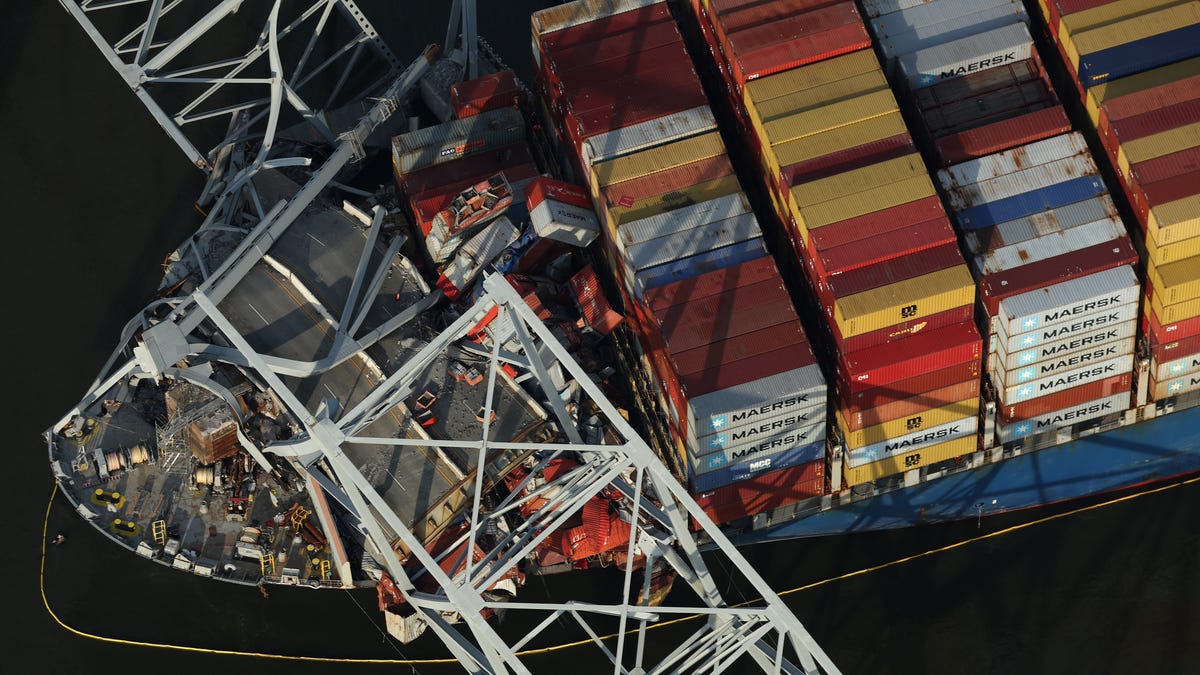Clean up crews are starting to clear the mess made by the MV Dali when it lost power and crashed into the Franklin Key Bridge late last month. The first step? Removing just 140 of the 4,700 of so containers onboard—a process that is expected to take weeks.
Even with nearly 5,000 containers onboard, the MV Dali was only filled to half of its capacity of its 10,000-container capacity when it lost power and slammed into the bridge on March 26, the Associated Press reports. Still, that seems like an awful lot of shipping containers, and that’s just one ship; there are tens of millions of these ubiquitous metal boxes moving around the world at any given time.
Shipping containers are so common they often blend into the background, but these humble 20 (or 40)-foot metal boxes are a recent invention, and we can thank (or curse) them for creating the modern world. Forbes once called the shipping container the greatest invention of the 20th Century. The New York Times called the humble shipping container “…one of the most significant, yet least noticed, economic developments of the last few decades,” and the U.S. government say containers “…revolutionized the shipping industry.”
So what makes shipping containers so revolutionary? First (my favorite part) a little history:
Up until about 50 or 60 years ago, freight was moved across the world in individual containers. Ships were a Tetris game of fitting non-standard barrels, boxes pallets and even whole cars into a cargo hold. The work was labor intensive and time consuming, with longshoremen taking days to properly stow and secure freight. This process was dangerous for the longshoremen, who often had no idea what materials they were handling, and expensive for shipping companies. The customers were hit right in the wallet as well; they had to store merchandise in warehouses as it awaited boarding and distribution.
Enter Malcom McLean, founder of a North Carolina trucking company Sea-Land Service. He had the brilliant idea to standardize shipping, so that materials could easily be fitted on to ships, transferred to trucks, and then brought to distribution centers or directly to customers.
While the inovation took time to catch on, and there were inevitable missteps, the idea was too good not to implement. It is no overstatement to say McLean’s idea built the modern globalized economy, according to the New York Times:
Just as the computer revolutionized the flow of information, the shipping container revolutionized the flow of goods. As generic as the 1’s and 0’s of computer code, a container can hold just about anything, from coffee beans to cellphone components. By sharply cutting costs and enhancing reliability, container-based shipping enormously increased the volume of international trade and made complex supply chains possible.
“Low transport costs help make it economically sensible for a factory in China to produce Barbie dolls with Japanese hair, Taiwanese plastics and American colorants, and ship them off to eager girls all over the world,” writes Marc Levinson in the new book “The Box: How the Shipping Container Made the World Smaller and the World Economy Bigger” (Princeton University Press).
For consumers, this results in lower prices and more variety. “People now just take it for granted that they have access to an enormous selection of goods from all over the world,” Mr. Levinson said in an interview. That selection, he said, “was made possible by this technological change.”
This revolution, much like every revolution, had some dire, unforeseen consequences as well. Port cities that swiftly embraced the change boomed while other ports withered. Longshoremen lost their jobs as well as folks working in local manufacturing, which suffered as companies found it was cheaper to build overseas and then ship products, rather than build at home.
Cargo ships grew to behemoth size to accommodate even more containers which naturally caused a spike in carbon dioxide pollution. Cargo ships now account for three percent of global emissions, according to the World Bank, similar to industrialized countries like Japan and German.
These building-size ships are also a particular pain when they take out essential shipping infrastructure, such as the MV Ever Given incident in 2021 which shut down the Suez Canal for almost a week, or last month’s collapse of the Franklin Key Bridge after the MV Dali crash. Now, so many goods are moved via shipping container that a shortage of the containers themselves can affect global trade with disastrous consequences.
That’s not to mention the increase in cheap, often exploitative manufacturing which has led to the thoughtless overconsumption we all enjoy to this day, leading to more waste and more pollution.
Doesn’t seem like such a simple little box now, does it?


/cdn.vox-cdn.com/uploads/chorus_asset/file/23437484/acastro_220503_STK084_0001.jpg)




